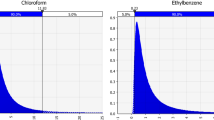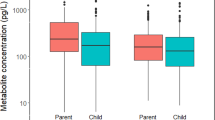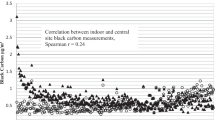Abstract
Personal exposures to volatile organic compounds (VOCs) were measured in the three industrial cities in the Czech Republic, Ostrava, Karvina and Havirov, while the city of Prague served as a control in a large-scale molecular epidemiological study identifying the impacts of air pollution on human health. Office workers from Ostrava and city policemen from Karvina, Havirov and Prague were monitored in the winter and summer of 2009. Only adult non-smokers participated in the study (N=160). Radiello-diffusive passive samplers were used to measure the exposure to benzene, toluene, ethylbenzene, meta- plus para-xylene and ortho-xylene (BTEX). All participants completed a personal questionnaire and a time–location–activity diary (TLAD). The average personal BTEX exposure levels in both seasons were 7.2/34.3/4.4/16.1 μg/m3, respectively. The benzene levels were highest in winter in Karvina, Ostrava and Prague: 8.5, 7.2 and 5.3 μg/m3, respectively. The personal exposures to BTEX were higher than the corresponding stationary monitoring levels detected in the individual localities (P<0.001; except m,p-xylene in summer). The indoor environment, ETS (environmental tobacco smoke), cooking, a home-heating fireplace or gas stove, automobile use and being in a restaurant were important predictors for benzene personal exposure. Ostrava's outdoor benzene pollution was a significant factor increasing the exposure of the Ostrava study participants in winter (P<0.05).
This is a preview of subscription content, access via your institution
Access options
Subscribe to this journal
Receive 6 print issues and online access
$259.00 per year
only $43.17 per issue
Buy this article
- Purchase on Springer Link
- Instant access to full article PDF
Prices may be subject to local taxes which are calculated during checkout
Similar content being viewed by others
References
Hoxha M., Dioni L., Bonzini M., Pesatori A.C., Fustinoni S., and Cavallo D., et al. Association between leukocyte telomere shortening and exposure to traffic pollution: a cross-sectional study on traffic officers and indoor office workers. Environ Health 2009: 8: 41.
Künzli N., and Tager I.B. Air pollution: from lung to heart. Swiss Med Wkly 2005: 135 (47–48): 697–702.
Sorensen M., Autrup H., Moller P., Hertel O., Jensen S.S., and Vinzents P., et al. Linking exposure to environmental pollutants with biological effects. Mutat Res 2003: 544 (2–3): 255–271.
World Health Organization. WHO air quality guidelines for Europe, 2nd edn. WHO Regional Office for Europe; Copenhagen, Denmark, 2000.
World Health Organization. WHO Guidelines for Indoor Air Quality: Selected Pollutants. WHO European Centre for Environment and Health, Bonn Office, WHO Regional Office for Europe, 2010.
Jurvelin J. Personal Exposures to Volatile Organic Compounds and Carbonyls: Relationship to Microenvironment Concentrations and Analysis of Sources. Department of Environmental Health Laboratory of Air Hygiene Helsinki, Finland: National Public Health Institute, 2003 p. 92.
Crebelli R., Tomei F., Zijno A., Ghittori S., Imbriani M., and Gamberale D., et al. Exposure to benzene in urban workers: environmental and biological monitoring of traffic police in Rome. Occup Environ Med 2001: 58 (3): 165–171.
Topp R., Cyrys J., Gebefugi I., Schnelle-Kreis J., Richter K., and Wichmann H.E., et al. Indoor and outdoor air concentrations of BTEX and NO2: correlation of repeated measurements. J Environ Monit 2004: 6 (10): 807–812.
Wallace L.A. Human exposure to volatile organic pollutants: implications for indoor air studies. Annu Rev Energy Environ 2001: 26: 269–301.
International Agency for Research on Cancer (IARC). Monographs on the Evaluation of Carcinogenic Risks to Humans 2009. Available at http://monographs.iarc.fr/ENG/Classification/index.php.
Han X., and Naeher L.P. A review of traffic-related air pollution exposure assessment studies in the developing world. Environ Int 2006: 32 (1): 106–120.
Upmanis H., Eliasson I., and Andersson-Skold Y. Case studies of the spatial variation of benzene and toluene concentrations in parks and adjacent built-up areas. Water Air Soil Pollut 2001: 129 (1–4): 61–81.
Adgate J.L., Eberly L.E., Stroebel C., Pellizzari E.D., and Sexton K. Personal, indoor, and outdoor VOC exposures in a probability sample of children. J Expo Anal Environ Epidemiol 2004: 14: 4–13.
Brunekreef B., and Holgate S.T. Air pollution and health. Lancet 2002: 360: 1233–1242.
Cocheo V., Sacco P., Boaretto C., De Saeger E., and Ballesta P.P., et al. Urban benzene and population exposure. Nature 2000: 409: 141–142.
Delgado-Saborit J.M., Aquilina N.J., Meddings C., Baker S., and Harrison R.M. Relationship of personal exposure to volatile organic compounds to home, work and fixed site outdoor concentrations. Sci Total Environ 2011: 409 (3): 478–488.
Czech Statistical Office.. 2010 Available at: http://www.czso.cz/eng/redakce.nsf/i/home (Accessed June 10, 2010).
Czech Hydrometeorological Institute, CHMI.. State of the Environment in Different Regions of the Czech Republic. Ministry of Environment of the Czech Republic, 2008 Available at: http://portal.chmi.cz/portal/dt?JSPTabContainer.setSelected=JSPTabContainer%2FP1_0_Home&last=false (Accessed June 20, 2010).
Pennequin-Cardinal A., Plaisance H., Locoge N., Ramalho O., Kirchner S., and Galloo J.C. Performances of the Radiello® diffusive sampler for BREX measurements: Influence of environmental conditions and determination of modeled sampling rates. Atmos Environ 2005: 39: 2535–2544.
Chatzis C., Alexopoulos E.C., and Linos A. Indoor and outdoor personal exposure to benzene in Athens, Greece. Sci Total Environ 2005: 349 (1–3): 72–80.
Strandberg B., Sunesson A.L., Olsson K., Levin J.O., Ljungqvist G., and Sundgren M., et al. Evaluation of two types of diffusive samplers and adsorbents for measuring 1,3-butadiene and benzene in air. Atmos Environ 2005: 39: 4101–4110.
Strandberg B., Sunesson A.L., Sundgren M., Levin J.O., Sallsten G., and Barregard L. Field evaluation of two diffusive samplers and two adsorbent media to determine 1,3-butadiene and benzene levels in air. Atmos Environ 2006: 40: 7686–7695.
Svecova V., Topinka J., Solansky I., Rossner Jr P., and Sram R.J. Personal exposure to carcinogenic polycyclic aromatic hydrocarbons in the Czech Republic. J Expo Anal Environ Epidemiol 2012 (in press).
Alexopoulos E.C., Chatzis C., and Linos A. An analysis of factors that influence personal exposure to toluene and xylene in residents of Athens, Greece. BMC Public Health 2006: 6: 50.
Delgado-Saborit J.M., Aquilina N.J., Meddings C., Baker S., Vardoulakis S., and Harrison R.M. Measurement of personal exposure to volatile organic compounds and particle associated PAH in three UK regions. Environ Sci Technol 2009: 43 (12): 4582–4588.
Kinney P.L., Chillrud S.N., Ramstrom S., Ross J., and Spengler J.D. Exposures to multiple air toxics in New York City. Environ Health Perspect 2002: 110 (Suppl 4): 539–546.
Bagryantseva Y., Novotna B., Rossner Jr P., Chvatalova I., Milcova A., and Svecova V., et al. Oxidative damage to biological macromolecules in Prague bus drivers and garagemen: impact of air pollution and genetic polymorphisms. Toxicol Lett 2010: 199 (1): 60–68.
Rossner Jr P., Svecova V., Milcova A., Lnenickova Z., Solansky I., and Sram R.J. Seasonal variability of oxidative stress markers in city bus drivers - Part II: oxidative damage to lipids and proteins. Mutat Res 2008: 642: 21–27.
Rossnerova A., Spatova M., Rossner P., Solansky I., and Sram R.J. The impact of air pollution on the levels of micronuclei measured by automated image analysis. Mutat Res 2009: 669 (1–2): 42–47.
Acknowledgements
This study was supported by the Ministry of Environment of the Czech Republic (CZ:MZP CR:SP/1b3/8/08) and the Ministry of Education, Youth and Sports of the Czech Republic (CZ:MSMT CR:2B08005). We are very grateful to all of the study participants, who contributed tremendously to the success of this project. A special thank goes to the cooperating institutions and executives that helped with the coordination of the monitoring campaigns: the Regional Authority of Ostrava and the Municipal Police in Karvina, Havirov and Prague.
Author information
Authors and Affiliations
Corresponding author
Ethics declarations
Competing interests
The authors declare no conflict of interest.
Additional information
Supplementary Information accompanies the paper on the Journal of Exposure Science and Environmental Epidemiology website
Supplementary information
Rights and permissions
About this article
Cite this article
Svecova, V., Topinka, J., Solansky, I. et al. Personal exposure to volatile organic compounds in the Czech Republic. J Expo Sci Environ Epidemiol 22, 455–460 (2012). https://doi.org/10.1038/jes.2012.30
Received:
Accepted:
Published:
Issue Date:
DOI: https://doi.org/10.1038/jes.2012.30
Keywords
This article is cited by
-
Characteristics and health risk assessment of volatile organic compounds (VOCs) in restaurants in Shanghai
Environmental Science and Pollution Research (2020)



